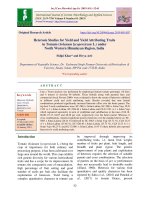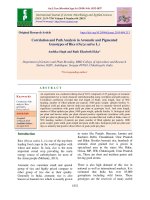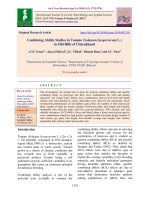Correlation and path analysis studies for yield in tomato (Solanum lycopersicum L.)
Bạn đang xem bản rút gọn của tài liệu. Xem và tải ngay bản đầy đủ của tài liệu tại đây (351.18 KB, 9 trang )
Int.J.Curr.Microbiol.App.Sci (2019) 8(9): 489-497
International Journal of Current Microbiology and Applied Sciences
ISSN: 2319-7706 Volume 8 Number 09 (2019)
Journal homepage:
Original Research Article
/>
Correlation and Path Analysis Studies for Yield in
Tomato (Solanum lycopersicum L.)
Archana Mishra1*, A. Nandi2, A.K. Das1, S. Das2, I.C. Mohanty3,
S.K. Pattanayak4, G.S. Sahu1 and P. Tripathy1
1
Department of Vegetable Science, 3Department of Agricultural Biotechnology,
Department of Soil Science and Agricultural Chemistry, College of Agriculture, Odisha
University of Agriculture and Technology, Bhubaneswar, India
2
AICRP on Vegetable Crops, Directorate of Research, Odisha University of Agriculture and
Technology, Bhubaneswar, India
4
*Corresponding author
ABSTRACT
Keywords
Correlation and
Path analysis,
Tomato, Genotypes
and Yield
Article Info
Accepted:
04 August 2019
Available Online:
10 September 2019
Correlation and path analysis were carried out in forty-five tomato hybrids along
with ten parents for yield. The association studies showed that fruit yield per plant
was positively and significantly correlated with average fruit weight. However,
fruit yield per plant was negatively correlated with number of cluster per plant,
length of fruits, total number of branches per plant, TSS and ascorbic acid content
of fruit. Path analysis studies done to study the cause and effect relationship
revealed that number of flowers per cluster, number of fruits per cluster, number
of fruits per plant, number of locules per fruit and average fruit weight had high
positive direct effects on fruit yield per plant. Hence, direct selection for these
traits is done for improving fruit yield per plant.
Introduction
Tomato (Solanum lycopersicum L.) is a
member of the family solanaceae and
significant warm season fruit vegetable crop
of special economic importance in the
horticultural industry worldwide (He et al.,
2003). Tomato is a native of Peru Equador
region (Rick, 1969) and having chromosome
number 2n=24. Tomato is the most important
vegetable crop next only to potato because of
its high yielding potential, wider adaptability
and multipurpose uses. It is widely consumed
vegetable crop throughout the world both for
fresh fruit market and the processed food
industry. It is grown at farm and kitchen
garden for slice, soup, sauce, ketchup, cooked
vegetable etc. It is a rich source of vitamins A,
B and C. Tomato is grown as an annual or
short lived perennial herbaceous plants. It has
taproot and growth habit of the plant is
determinate,
semi-determinate
and
489
Int.J.Curr.Microbiol.App.Sci (2019) 8(9): 489-497
indeterminate. Yield is a complex character
and selection for yield and yield components
deserves considerable attention. A crop
breeding programme, aimed at increasing the
plant productivity requires consideration not
only of yield but also of its components that
have direct or indirect effect on yield.
Correlation and path coefficient analysis give
an insight into the genetic variability present
in populations. Correlation coefficient analysis
measures the mutual relationship between
various plant characters and determines the
component characters on which selection can
be based for improvement in yield. Path
analysis splits the correlation coefficients into
direct and indirect effects of a set of dependent
variables on the independent variable thereby
aids in selection of elite genotype. An
improvement in yield in self pollinated crop
like tomato is normally achieved by selecting
the genotypes with desirable character
combinations existing in nature or by
hybridization. Information on the nature and
extent of variability present in genetic stocks,
heritability,
genetic
advance
and
interrelationship among various characters is a
prerequisite for framing any selection
program. The present study was carried out to
get the information for character association
for yield in fifty-five genotypes of tomato.
Materials and Methods
Fifty-five genotypes of tomato consisting of
45 F1 hybrids and 10 parents were evaluated in
a randomized block design with two
replications at Department of Vegetable
Science, College of Agriculture, Orissa
University of Agriculture and Technology,
Bhubaneswar. Seeds sowing in the nursery
beds was carried out on October 9th and
transplanting was done on 8th November,
2016. All recommended cultural practices
were followed to raise good crop stand and
growth of the plants. The observation were
recorded on five randomly selected plants per
replication for each germplasm on eighteen
different characters: days to 1st flowering,
days to 50% flowering, number of cluster per
plant, number of flowers per cluster, number
of fruits per cluster, number of fruits per plant,
length of fruits, diameter of fruits, pericarp
thickness, number of locules per fruit, plant
height, total number of branches, average fruit
weight, yield per plant, total yield per plot,
TSS, acidity content of fruit and ascorbic acid
content of fruit. The correlations of
coefficients among yield and quality attributes
were calculated as suggested by Panse and
Sukhatme (1985). Path coefficient analysis
was carried out according to Dewey and Lu
(1959).
Results and Discussion
The mean value for yield per plant of the
genotypes revealed that the highest value
being shown by BT-22-4-1 (2.565) followed
by BT-22-4-1 X BT-3 (2.495), BT-22-4-1 X
BT-17-2 (2.405), BT-19-1-1-1 X BT-22-4-1
(2.105) and the lowest value possess by BT-1
X BT-22-4-1 (0.165) followed by Utkal
Kumari X BT-19-1-1-1 (0.570), BT-1 (0.740)
and BT-1 X Utkal Kumari (0.750) (Table 1).
The range for yield per plant of tomato
genotypes under study is (0.165-2.565).
Simple correlation studies were carried for all
the characters studied. The degree of
association between fruit yield and its
contribution can be estimated by correlation
coefficient at genotypic and phenotypic levels.
All possible phenotypic and genotypic
correlation coefficient between fruit yield and
its components was calculated and is given in
(Tables 2 and 3). For most of the characters
genotypic correlation coefficient was found
higher than phenotypic correlation coefficient
indicating a strong inherent association among
various characters. Similar findings were
observed by Mohanty (2003) and Singh
490
Int.J.Curr.Microbiol.App.Sci (2019) 8(9): 489-497
(2009). Average fruit weight had significant
positive correlation with fruit yield per plant.
The results are in accordance with Kumar et
al., (2006) for average fruit weight. The
genotypic association of days to 50%
flowering showed significant positive
association with length of fruits. Similarly a
significant and positive correlation of number
of flowers per cluster was found with number
of fruits per cluster, number of locules per
fruit, plant height and average fruit weight
while diameter of fruits was found to be in
positive and significant association with
number of locules per fruit. Results are in
accordance with Singh (2009) and Ara et al.,
(2009). Days to first flowering and days to
50% flowering showed significant negative
association with number of flowers per
cluster. Similarly number of cluster per plant
exhibited negative significant association with
average fruit weight and positively correlated
with number of flowers per cluster, number of
fruits per plant, number of locules per fruit,
total number of branches per plant, TSS and
ascorbic acid content while number of flowers
per cluster had negative significant correlation
with diameter of fruits and positive association
with length of fruits, pericarp thickness, total
number of branches per plant, TSS, ascorbic
acid and acidity content. Number of fruits per
plant showed significant negative association
with plant height while positively correlated
with length and diameter of fruits, pericarp
thickness, total number of branches per plant,
TSS and ascorbic acid content. Same
observations were made by Singh et al.,
(2007) and Singh (2009) for number of fruits
per plant. The phenotypic association of days
to 50% flowering exhibited significant
positive correlation with days to 50%
flowering while number of flowers per cluster
showed the same with number of fruits per
cluster. The results observed are similar to the
findings of Dhankar and Dhankar (2006).
Yield per plant had positive association with
days to first flowering, days to 50% flowering,
number of flowers per cluster, number of
fruits per cluster, number of fruits per plant,
diameter of fruits, pericarp thickness, number
of locules per fruit, plant height and acidity
content while had negative association with
number of cluster per plant, length of fruits,
total number of branches per plant, TSS and
ascorbic acid content. Similar results for some
characters are also observed by Prashanth et
al., (2008). Average fruit weight had positive
association with days to first flowering, days
to 50% flowering number of fruits per cluster,
plant height, TSS and acidity content while
had negative association with ascorbic acid
acid content, fruit length and pericarp
thickness. Results are in accordance with
Kumar and Dudi (2011). TSS had positive
association acidity content while negatively
correlated with ascorbic acid content.
Ascorbic acid had negative association with
TSS. Results are in accordance with Kumar
and Dudi (2011) for fruit weight, TSS, acidity.
The path coefficient studies (Table 4) revealed
that plant number of fruits per cluster, number
of flowers per cluster, number of fruits per
plant, average fruit weight and number of
locules per fruit had high positive direct
effects on fruit yield per plant while days to
first flowering, days to 50% flowering, fruit
diameter, pericarp thickness and plant height
had moderate direct positive effects on fruit
yield per plant. High negative direct effects on
fruit yield per plant had been observed for
number of cluster per plant, fruit length, total
number of branches per plant, TSS, ascorbic
acid and acidity content. The results are in
accordance with the findings of Asati et al.,
(2008) for plant height, number of primary
branches per plant, days to 50% flowering and
fruit weight, Kumar and Thakur (2007) for
number of fruits per plant, fruit length and
fruit width.
491
Int.J.Curr.Microbiol.App.Sci (2019) 8(9): 489-497
Table.1 Mean of 45 F1 hybrids and 10 parent
GENOTYPES
YIELD
PLANT-
V28
V29
1
V1
V2
V3
V4
V5
V6
V7
V8
V9
V10
V11
V12
V13
V14
V15
V16
V17
V18
V19
V20
V21
V22
V23
V24
V25
V26
V27
Bt-1 x Utkal Dipti
BT-1 x Utkal Kumari
BT-1 x BT-19-1-1-1
BT-1 x BT-317
BT-1 x BT-22-4-1
BT-1 x BT-3
BT-1 x BT-17-2
BT-1 x BT-507-2-2
BT-1 x BT-21
Utkal Dipti x Utkal
Kumari
Utkal Dipti x BT-19-1-1-1
Utkal Dipti x BT-317
Utkal Dipti x BT-22-4-1
Utkal Dipti x BT-3
Utkal Dipti x BT-17-2
Utkal Dipti x BT-507-2-2
Utkal Dipti x BT-21
Utkal Kumari x Bt-19-11-1
Utkal Kumari x BT-317
Utkal Kumari x BT-22-41
Utkal Kumari x BT-3
Utkal Kumari x BT-17-2
Utkal Kumari x BT-5072-2
Utkal Kumari x BT-21
BT-19-1-1-1 x Bt-317
BT-19-1-1-1 x BT-22-4-1
BT-19-1-1-1 x BT-3
1.045
0.750
1.095
0.965
0.165
1.495
1.450
1.195
1.310
V30
V31
V32
V33
V34
V35
V36
V37
V38
V39
V40
V41
V42
V43
V44
V45
V46
V47
V48
V49
V50
V51
V52
V53
V54
V55
SED
CD
0.850
1.185
1.060
2.050
1.350
1.295
1.030
1.085
0.570
0.840
1.490
1.160
1.095
1.000
1.180
0.840
2.105
1.205
492
BT-19-1-1-1 x BT-17-2
BT-19-1-1-1 x BT-507-22
BT-19-1-1-1 x BT-21
BT-317 x BT-22-4-1
BT-317 x BT-3
BT-317 x BT-17-2
BT-317 x BT-507-2-2
BT-317 x BT-21
BT-22-4-1 x BT-3
BT-22-4-1 x BT-17-2
BT-22-4-1 x BT-507-2-2
BT-22-4-1 x BT-21
BT-3 x BT-17-2
BT-3 x BT-507-2-2
BT-3 x BT-21
BT-17-2 x Bt-507-2-2
BT-17-2 x BT-21
BT-507-2-2 x Bt-21
BT-1
Utkal Dipti
Utkal Kumari
BT-19-1-1-1
BT-317
BT-22-4-1
BT-3
BT-17-2
BT-507-2-2
BT-21
1.295
1.385
1.170
1.215
1.685
1.410
1.340
1.015
2.495
2.405
2.060
2.030
1.470
1.380
1.255
1.370
1.310
1.190
0.740
0.935
0.645
1.095
0.920
2.565
1.640
1.485
1.305
1.245
0.129
0.259
Int.J.Curr.Microbiol.App.Sci (2019) 8(9): 489-497
Table.2 Genotypic correlation co-efficient (rg) between all pairs of 17 characters in tomato
Characters
Days to 1st
flowering
Days to
50%
flowering
No. of
cluster/plant
No. of
flowers/clust
er
No. of
fruits/cluste
r
No. of
fruits/plant
Length of
fruits
Diameter of
fruits
Pericarp
thickness of
fruit
No. of
locules/fruit
Plant height
r
Days to 50% flowering
No. of
cluster/
plant
No. of
flowers/
cluster
No. of
fruits/
cluster
No. of
fruits/
plant
Length
of
fruits
Diamete
r of
fruits
-1.13902
-0.13042
-0.55081*
-0.12662
-0.12649
0.18004
0.14443
Pericar
p
thickne
ss of
fruit
0.15133
No. of
locules/
fruit
Plant
height
Total
no. of
branche
s/plant
Average
fruit
weight
0.24604
-0.14160
-0.23246
0.07171
-0.12566
Ascorbi
c acid
content
Acidity
content of
fruit
Yield/pla
nt
0.10602
-0.00138
0.07610
0.28786
0.00796
0.03787
-0.53999*
-0.36075
-0.23321
0.43270*
-0.26021
0.31008
0.21120
0.12395
0.03145
0.17267
-0.10335
0.15076
0.05652
-0.23688
0.31040
-0.38789
-0.03499
-0.11355
0.13793
-0.08923
0.34211
-0.56164**
0.02640
0.22117
-0.08670
-0.15970
0.94951**
-0.11423
0.21809
-0.42677*
0.14487
0.47090*
0.44999*
0.03456
0.43973*
0.02791
0.31150
0.33475
0.00829
0.10521
0.08859
0.07006
0.20141
0.24927
0.14150
0.11603
0.31234
0.14567
0.18517
0.16359
0.08529
0.00243
0.31796
0.08001
-0.23759
-0.44357*
0.16651
-0.24369
0.35606
0.10862
-0.37518
0.06112
0.04681
0.03726
0.19970
0.12739
0.23145
-0.11100
-0.06624
0.02345
-0.23074
-0.21288
0.37177
0.44738*
0.02603
-0.26310
0.15640
0.32378
-0.05490
0.28049
0.15579
0.20180
0.09222
-0.17705
-0.05846
0.06433
0.21047
-0.04285
0.04832
-0.13084
0.08563
0.16743
0.17371
0.20413
0.16727
0.08167
-0.00519
0.12786
0.04462
-0.13453
0.02455
0.05085
-0.36245
0.19290
-0.15940
-0.35047
-0.40893
-0.04071
-0.13416
0.22108
0.64190**
-0.23596
0.15194
-0.02976
-0.05970
-0.33896
g
r
TSS of
fruit
g
r
g
r
g
r
g
r
g
r
g
r
g
r
g
r
g
r
g
Total no. of
branches/pl
ant
Average
fruit weight
TSS of fruit
r
g
r
g
r
g
Ascorbic
acid content
Acidity
content of
fruit
r
g
r
0.13356
g
*and ** indicates significant at 5 and 1 percent level, respectively
493
Int.J.Curr.Microbiol.App.Sci (2019) 8(9): 489-497
Table.3 Phenotypic correlation co-efficient (rp) between all pairs of 17 characters in tomato
Characters
Days to 1st
flowering
Days to 50%
flowering
No. of
cluster/plant
No. of
flowers/cluste
r
No. of
fruits/cluster
No. of
fruits/plant
Length of
fruits
Diameter of
fruits
Pericarp
thickness of
fruit
No. of
locules/fruit
Plant height
Total no. of
branches/plan
t
Average fruit
weight
TSS of fruit
Ascorbic acid
content
Acidity
content of
fruit
rp
rp
rp
rp
Days to
50%
flowerin
g
No. of
cluster/pla
nt
No. of
flowers/
cluster
No. of
fruits/
cluster
No. of
fruits/
plant
Length
of fruits
Diamete
r of
fruits
0.594**
-0.081
0.099
0.148
0.107
-0.163
-0.104
0.226
0.158
0.109
-0.054
-0.105
0.818**
rp
rp
rp
rp
No. of
locules/
fruit
Plant
height
Total
no. of
branche
s/plant
Average
fruit
weight
TSS of
fruit
Ascorbic
acid
content
Acidity
content of
fruit
Yield/plant
-0.047
Pericar
p
thicknes
s of
fruit
0.091
-0.003
-0.008
-0.291
0.056
-0.094
0.066
0.046
0.104
-0.093
-0.016
0.182
-0.100
-0.017
-0.130
0.097
0.048
0.150
-0.003
0.040
0.218
-0.164
-0.094
-0.040
0.091
-0.052
0.208
-0.401
0.053
0.163
-0.092
-0.084
-0.025
0.081
0.123
0.069
-0.183
0.056
-0.007
0.127
0.035
0.089
0.036
0.010
0.041
0.047
0.198
0.048
-0.106
0.101
0.072
0.178
0.100
0.103
0.067
0.049
-0.066
0.143
0.035
-0.082
-0.232
0.104
-0.150
0.285
0.088
-0.313
0.082
-0.004
0.036
0.069
-0.008
0.139
-0.133
-0.017
0.012
-0.139
-0.184
0.172
0.090
-0.069
-0.069
0.021
0.156
-0.022
0.170
0.052
0.062
-0.019
-0.166
-0.049
0.063
0.172
-0.040
0.039
-0.006
0.062
0.120
0.120
0.140
0.153
0.065
0.034
0.102
-0.262
0.014
0.141
-0.102
-0.122
0.050
-0.253
0.005
-0.281
0.038
-0.128
0.175
0.600**
0.230
-0.148
-0.056
-0.022
-0.326
rp
rp
rp
rp
rp
rp
rp
rp
0.098
*and ** indicates significant at 5 and 1 percent level, respectively
494
Int.J.Curr.Microbiol.App.Sci (2019) 8(9): 489-497
Table.4 Estimate of direct (diagonal) and indirect effect of component characters on yield in tomato
Characters
Days to 1st
flowering
Days to 50%
flowering
No.of
cluster/plant
No.of
flowers/cluster
No.of
fruits/cluster
No.of fruits/plant
Length of fruits
Diameter of fruits
Pericarp thickness
of fruit
No.of locules/fruit
Plant height
Total no.of
branches/plant
Average fruit
weight
TSS of fruit
Ascorbic acid
content
Acidity content of
fruit
Days to
Days to
1st
50%
flowering flowering
No.of
cluster/
plant
No.of
flowers/
cluster
No.of
fruits/
cluster
No.of
fruits/
plant
Length of Diameter
fruits
of fruits
0.04121
0.21097
0.06469
-0.33001
0.10759
-0.07398
-0.07424
0.00176
0.01547
0.08842
-0.00604
0.01598
0.02811
0.01482
-0.02873
0.00007
Genotypic
correlatio
n with
Yield
/plant
0.07610
0.04694
0.18522
0.06233
-0.32352
0.30653
-0.13640
-0.17842
-0.00318
0.03171
0.07590
0.00529
-0.00216
0.06767
-0.02161
-0.07800
-0.00043
0.03787
0.00537
0.02328
-0.49602
0.03386
0.20128
0.18154
0.15994
-0.00043
-0.01161
0.04957
-0.00381
-0.02352
-0.22013
-0.00378
-0.05993
0.00470
-0.15970
0.02270
0.10002
-0.02804
0.59913
-0.80681
-0.06681
-0.08993
-0.00521
0.01481
0.16922
0.01920
-0.00238
0.17235
-0.00400
-0.08441
-0.01814
0.00829
0.00522
0.06682
0.11750
0.56888
0.84971
0.06154
-0.03653
0.00086
0.02060
0.08958
0.00604
-0.00798
0.12242
-0.02088
-0.05018
-0.00886
0.08529
0.00521
-0.00742
-0.00595
-0.00624
0.04320
-0.08014
0.04820
-0.05743
-0.15397
0.19240
0.01736
0.05632
-0.06844
0.13066
-0.25569
0.08680
-0.08940
-0.07528
-0.05953
-0.17114
0.58487
0.00142
0.18596
0.04679
-0.00100
-0.41234
-0.01930
-0.01536
0.00388
0.00057
0.01221
0.00454
0.00818
0.00381
0.03802
0.10226
-0.08538
0.07176
0.16077
0.07252
-0.01893
0.00544
0.00111
0.00394
-0.01145
-0.01591
0.01809
0.01217
-0.09551
-0.04351
0.06130
-0.02291
-0.05104
0.00949
-0.04641
-0.00922
-0.02943
-0.00635
0.01488
-0.05703
0.02033
0.01250
-0.01520
0.00232
0.06112
-0.21288
0.15579
0.04832
-0.01014
0.00584
0.00958
-0.03912
-0.02296
-0.00583
-0.06841
0.04426
-0.16970
0.28213
0.26960
0.02070
-0.21181
-0.12023
-0.09859
-0.13896
-0.25943
0.09738
-0.08235
-0.05253
-0.09543
0.00546
0.00032
-0.00321
0.02063
0.00943
-0.01810
0.35936
-0.04702
0.03077
-0.00558
0.04267
-0.00022
-0.00589
0.00036
-0.06876
0.06562
0.05011
-0.14206
-0.02490
-0.00640
-0.02765
-0.05531
0.03645
-0.00906
-0.00133
0.01899
0.08167
0.05085
-0.40893
-0.00296
-0.03198
0.27859
0.26346
-0.26540
-0.14252
0.04577
0.00191
-0.00598
0.06017
0.00546
0.02492
0.39194
-0.00584
0.04319
0.03635
-0.01198
0.64190
0.00426
-0.00437
-0.02792
-0.05332
-0.01310
-0.10971
0.01672
0.18663
-0.12378
-0.15734
0.20825
0.06353
0.02731
-0.00967
0.00395
-0.00067
0.00658
0.02152
0.06242
0.07336
0.00190
-0.00574
-0.01326
0.01096
0.01596
-0.05258
-0.14335
-0.03382
-0.06394
-0.27098
0.00823
0.00324
-0.02976
-0.33896
0.00006
-0.00147
0.04300
0.20056
-0.13901
-0.21943
0.09514
0.00342
-0.00438
0.06011
0.00105
0.02410
0.08665
0.02178
0.01618
-0.05419
0.13356
Residual effect = 0.6944423
Figures underlined denoted the Direct Effect
495
Pericarp
thickness
of fruit
No. of
locules/
fruit
Plant
height
Total
no. of
branche
s/plant
Average
fruit
weight
TSS of
fruit
Ascorbi
c acid
content
Acidity
content
of fruit
Int.J.Curr.Microbiol.App.Sci (2019) 8(9): 489-497
simple sequence repeat (SSR) markers
and their
use in
determining
relationships
among
Lycopersicon
esculentum
cultivars.
Theoretical
Applied Genetics, 106: 363-373.
Kumar, M. and Dudi, B.S. (2011). Study of
correlation for yield and quality
characters in tomato (Lycopersicon
esculentum Mill.). Electronic Journal of
Plant Breeding, 2(3): 453-460.
Kumar, R and Thakur, M.C. (2007). Genetic
variability, heritability, genetic advance,
correlation coefficient and path analysis
in tomato. Haryana Journal of
Horticultural Science, 36(3 & 4): 370373.
Kumar, R., Niraj Kumar, Jagadeesh Singh
and Rai, G.K. (2006). Studies on yield
and quality traits in tomato. Vegetable
Science, 33(2): 126-132.
Mohanty BK (2003). Variability, heritability,
correlation and path coefficient studies
in
tomato.
Indian
Journal
of
Agricultural Research, 37(1): 68-71.
Panse VG, Sukhatme PV. (1985). Statistical
Methods for Agricultural Workers (2nd
Edn.), Indian Council of Agricultural
Research, New Delhi, 381.
Prashanth, S.J., Jaiprakashnarayan, R.P.,
Mulge, R. and Madalageri, M.B.
(2008). Correlation and path analysis in
tomato
(Lycopersicon
esculentum
Mill.).
The Asian
Journal
of
Horticulture, 3(2): 403-408.
Rick C M. (1969). Origin of cultivated
tomato, current status and the problem.
International Botanical Congress, 180p.
Singh AK (2009). Genetic variability,
heritability and genetic advance studies
in tomato under cold arid region of
Ladakh. Indian Journal of Horticulture
66(3): 400-403.
Singh, J., Mathura Rai, Rajesh Kumar,
Prasanna, H.C., Ajay Verma Rai, G.K.
and Singh, A.K. (2007). Genotypic
variation and hierarchical clustering of
Acknowledgement
This research was supported/partially
supported by Department of Vegetable
Science, College of Agriculture, OUAT,
Bhubaneswar and DST, Government of India.
We thank our colleagues from Odisha
University of Agriculture and Technology
who provided insight and expertise that
greatly assisted the research, although they
may not agree with all of the
interpretations/conclusions of this paper.
We would also like to show our gratitude to
the Professors of Department of Agricultural
Biotechnology and Department of Soil
Science and Agricultural Chemistry, College
of Agriculture, OUAT, Bhubaneswar for
sharing their pearls of wisdom with us during
the course of this research. We are also
immensely grateful to the workers of AICRP
on Vegetable Crops, Directorate of Research,
OUAT, Bhubaneswar.
References
Ara A, Narayan R, Ahmed N and Khan SH.
(2009). Genetic variability and selection
parameters for yield and quality
attributes in tomato. Indian Journal of
Horticulture 3(2): 222 225.
Asati, B.S., Rai, N. and Singh, A.K. (2008).
Genetic parameters study for yield and
quality traits in tomato. The Asian
Journal of Horticulture, 3(2): 222-225.
Dewey DR, Lu KH. (1959). A correlation and
path co-efficient analysis of components
of crested wheat grass seed production.
Agronomy Journal, 51(9):515-518.
Dhankhar, S.K. and Dhankar, S.S. (2006).
Variability, heritability, correlation and
path coefficient studies in tomato.
Haryana Journal of Hortcultural
Science, 35(1&2): 179-181.
He, C., Poysa, V. and Yu, K. (2003).
Development and characterization of
496
Int.J.Curr.Microbiol.App.Sci (2019) 8(9): 489-497
tomato (Solanum lycopersicum) based
on morphological and biochemical
traits, Vegetable Science. 34(1): 40-45.
How to cite this article:
Archana Mishra, A. Nandi, A.K. Das, S. Das, I.C. Mohanty, S.K. Pattanayak, G.S. Sahu and
Tripathy, P. 2019. Correlation and Path Analysis Studies for Yield in Tomato (Solanum
lycopersicum L.). Int.J.Curr.Microbiol.App.Sci. 8(09): 489-497.
doi: />
497
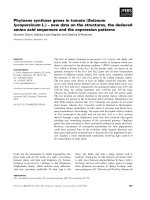
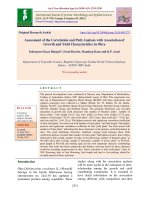

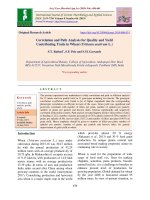
![Studies on correlation and path analysis for grain yield and quality components in foxtail millet [Setaria italica (L.) Beauv.]](https://media.store123doc.com/images/document/2020_01/09/medium_dyd1578574836.jpg)

